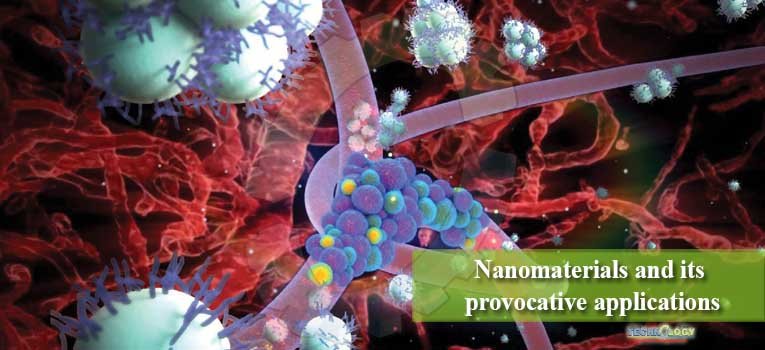The behavior of nanoscale materials differs in fundamental ways from that observed at the macro- and the microscales. New physics and chemistry come into play.
 Dimensions, composition and structure, are all impact material properties in nanoscale materials. At least two factors dominate this transition. The first is that nanometer dimensions approach characteristic (quantum) wave function scales of excitations in the material electrons and holes, photons, spinwaves, and magnons, among others.
Dimensions, composition and structure, are all impact material properties in nanoscale materials. At least two factors dominate this transition. The first is that nanometer dimensions approach characteristic (quantum) wave function scales of excitations in the material electrons and holes, photons, spinwaves, and magnons, among others.
The second is the very large surface -to- volume ratio of these structures, which means that no atom is very far from an interface and that interatomic forces and chemical bonds dominate. Nanaoscale materials require an approach to fabrication fundamentally different from that of microtechnology.
Microscale structures are typically formed by top-down techniques such as deposition, etching and pattering. The particle formation structures at nanoscale dimension will probably involve an additional component, bottom-up assembly self-assembly, a process whereby structures are built up from atomic or molecular-scale units into larger and increasingly complex structure is widely used by biological systems.
When fully developed. Bottom–up fabrication using self-assembly and related methodologies will be able to produce ordered, precisely controlled nanomaterials and nanodevices not achieved by current methods such as lithography and other top-down techniques .
Other directions of self-assembly research include kinesis powdered microdevices (molecular motors) ; nano-optics in the biological world ; biomedical applications ; and molecular –based materials in electronic devices, light=emitting diodes, quantum dot lasers, and photovoltaic devices (24).As a field of endeavor with widespread applicability, self-assembly is just beginning a new era for the production of new materials.
Application of Nanomaterials
More recently, scientists working on the nanoscale have created a multitude of other nanoscale components and devices, including: tiny transistors, superconducting quantum dots, nanodiods, nanosensors, molecular pistons, supercapacitors ‘’biomolecular’’ motors, chemical motors, a nano train set, nanoscale elevators,
A DNA nanowalking robot, nanothermometers, nano containers, the beginning of a miniature chemistry set, nano-Velcro, nanotweezers, nano weighing scale, a nano abacus, a nano guiter, a nanoscale fountain pen, and even a nanosized soldering iron.
The five exciting applications of nanotechnology :
- Nanopowders: these particles have size less than of 100 nm, having unusual properties because of their sizes. Nanoparticles have a wide range of applications, such as plastics that behave like ceramics or metals; new catalyst for environmental remediation; improved food shelf-life and packaging; and novel drug delivery devices. Nanoparticle can be applied to cotton and silk for nano jacket, nano scarf.
- Carbon Nnaotubes: Graphenes, fullerenes and carbon nanotubes (CNT) are carbon-based nanostructuresCarbon nanotubes are used in sensor, fuel cells (hydrogen storage), computers, optical devices, electrical devices, (quantum dots) and nanoscale engineering (nanometers). The nano-biosensor, which single wall CNTS anchored to gold-coated nanotubes, for detecting blood glucose and potentially many other biological molecules. The applications areas of biosensors are: drug discovery, bacteriological detection, veterinary diagnostics, food testing and environmental monitoring.
- Nanomembrane filtration system: safe, clean, affordable, water are major problems of the 12 1st Filters with nanometer-scale pores can remove 100 per cent of bacteria and viruses. The ability of recycle of water from any source for any use can save huge amounts of water. Nanomembrane filtration devices that ‘clean’ polluted water, sifting out bacteria, viruses, heavy metals and organic material are being explored by research teams worldwide.
- Quantum dots: these are small device that contain a tiny droplet of free electrons—essentially artificial atoms.
It appears that nanostructure science and technology at present resembles only the tip of a pyramid that has recently been uncovered from the sands of ignorance.
Scientists worldwide dig away at these sands and uncovers more and more of the exciting field of nanostructure science and technology, we will eventually learn how truly important the field will have become and how great its impact will be on society. From our present vantage point, this future looks very exciting.
References:
- Implications of Emerging Micro Committee, National Research Council, The National AcademiesPress, Washington, D.C., USA, (2002).
- G.M. Whitesides, and J.C., Love. The art of building small-Researchers are discovering cheap, efficient ways to make structures only a few billionths of a meter across. Scientific American Vol. 285, No. (3): pp. 38-47, (2001).
- L. Limberis, and R.J. Stewart, Toward kinesis-powered microdevices. Nanotechnology, Vol.11, No (2), pp. 47-51, (2000).
- 4. M. Srinivasarao, Nano-optics in the biological world: Beetles, butterflies, birds, and moths. Chemical Reviews Vol. 99 No. (1999).
- 5. A.P. Alivisatos, Less is more in medicine—–Sophisticated forms of nanotechnology will find some of their first real-world applications in biomedical research, disease diagnosis, and, possibly, therapy. Scientific American, Vol.285, No (3), pp 67-73, (2001).
- 6. D.E. Hooks, T. Fritz, and M.D. Ward. Epitaxy and molecular organization on solid substrates. Advanced Materials, Vol.3, No. (4): 227-241, (2001).
Authors: Tasbeeha Saeed, Dr. Tariq Mahmood, Umer Nawaz Khan